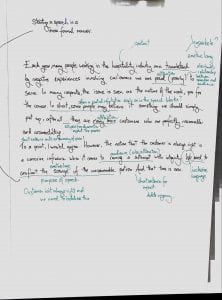In today’s lesson, we’ve been exploring possible structures and frameworks for a persuasive speech. The image below is a rather rough outline of possible ways to open these kinds of text.
One possible way is to begin your text with an anecdote, the human story. Please have a look at the image below to see what this might look like in practice:
This speech uses the hospitality sector as its context and the audience (which is implied rather than directly stated) are restaurant owners.
In this first example, note:
- How the anecdote establishes a relationship between the speaker and the audience.
- The setting of the restaurant is described using hyerbole. You CAN and SHOULD use what you know about narrative writing in persuasive texts to build that sense of drama, that sense of theatre. Take risks with language!
- I’ve used an ellipsis to add drama, the dramatic pause.
- I’ve used alliteration.
- I’ve used short sentences to add drama.
- Note how the tone shifts in the second paragraph to a more formal one.
- Inclusive language to establish relationship between speaker and audience.
The second version (below) adopts a more formal tone throughout:
The context, audience and purpose of this version is entirely the same, but:
- The tone is more consistent.
- Starts with a more formal statement, which establishes the context of the speech.
- Still uses hyperbole to gain the interest of the audience.
- Context, audience and purpose are implied rather than directly stated.
- Inclusive language.
- Alliteration.
- Ellipsis and short sentences to add drama/impact/theatre.
- Not sure if the partial refutation in the opening paragraph works. Think about whether it does or not, but it was designed to create a ‘them and us’ scenario which builds on the sense of injustice established earlier when I talk about how poorly paid people who wait tables are.
In short, how you open a persuasive text largely depends on the context, audience and purpose of your response.


